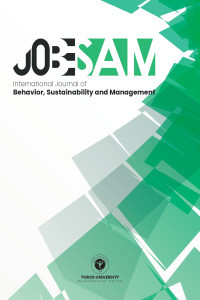SIVILAŞTIRILMIŞ DOĞAL GAZ TAŞIMA YOLLARININ AĞ TABANLI OPTİMİZASYONU
Kaza simülasyonu, LNG taşımacılığı, Risk analizi, Rota seçimi
NETWORK-BASED OPTIMIZATION OF LIQUEFIED NATURAL GAS TRANSPORTATION ROUTES
Accident simulation, LNG transport, Risk analysis, Route selection,
___
- [1] BP Statistical Review of World Energy 2019 at https://www.bp.com/content/dam/bp/business-sites/en/global/corporate/pdfs/energy-economics/statistical-review/bp-stats-review-2019-full-report.pdf
- [2] Dai Q. (2017). Research of Route Selection of Liquefied Natural Gas Road Transportation Based on Risk Analysis. South China University of Technology, 32
- [3] Phillips D.W. (2013). Hazardous Materials Transportation Risk Analysis – Quantitative Approaches for Truck and Train [J]. Taylor & Francis, 7(4). 10.1179/rmt.1996.7.4.309
- [4] Garrido R.A., Bronfman A.C. (2017). Equity and Social Acceptability in Multiple Hazardous Materials Routing Through Urban Area [J]. Transportation Research Part A. 102, 244-260. 10.1016/j.tra.2016.05.018
- [5] Harwood D.W., Viner J.G., Russell E.R. (1993). Procedure for developing truck accident and release rates for Hazmat routing [J]. Journal of Transportation Engineering, 119:2(2), 189-199. 10.1061/(ASCE)0733-947X(1993)119:2(189)
- [6] Bo H., Fery P. (2005). Aiding route decision for hazardous material transportation. Proceedings of the 84th TRB Annual Meeting. Washington, D.C.
- [7] Lv P. The Study of Hazardous Study Transportation Route Selection Based on GIS-AHP Method [A]. Road Transportation. 2011:75-78
- [8] M.de Beer., Fisher C., Jooste F.J. (1996). Determination of Reanimation Type Pavements with Thin Asphalt Surfacing Layers [C]. Eighth International Conference on Asphalt Pavement. 179-227
- [9] OpenStreetMap: https://www.openstreetmap.org/#map=11/38.9466/121.4212
- [10] Ren C., Wu Z., Li J. (2008). Multi-objective Pareto Optimal Route for Road Transportation of Dangerous Goods Based on Risk Analysis [J]. China Work Safety Science and Technology, 4(2), 9-13
- [11] Ren C. (2007) Research on optimization method of dangerous goods road transportation route based on risk analysis [D]. Nankai University
- [12] Saaty T. L. (1980).The Analytic Hierarchy Process [M]. New York: McGraw-Hill
- [13] Zeng J., Wang M., Liu Y. et al. (2011). Characteristics and prevention of road transport liquefied natural gas (LNG) accidents [C]. Advanced Forum on Transportation of China. 221-225
- [14] Zhou W., Ruan Y., Wang H. (2009). LNG tank truck road transportation hazard and its risk assessment [C]. LNG Professional Committee of China Urban Gas Society 2009 CBM Liquefaction Theme Annual Conference.
- Yayın Aralığı: Yılda 2 Sayı
- Başlangıç: 2023
- Yayıncı: Toros Üniversitesi
RESEARCH ON SUSTAINABLE CRITERIA AFFECTING THE LOGISTICS SECTOR
COPRAS ve EDAS Yöntemleriyle Yeşil Tedarikçi Seçimi
SIVILAŞTIRILMIŞ DOĞAL GAZ TAŞIMA YOLLARININ AĞ TABANLI OPTİMİZASYONU
FREIGHT TRANSPORTATION AND THE COVID-19 OUTBREAK: FRESH INSIGHTS FROM THE US ECONOMY
Esranur YILMAZ, Mehmet Aldonat BEYZATLAR
JAPONYA'DA SÜRDÜRÜLEBİLİR LOJİSTİK İÇİN MAKİNE ÖĞRENİMİ İLE YÜKSEK KAPASİTELİ ARAÇLARIN VERİ ANALİZİ
